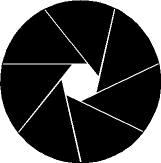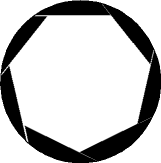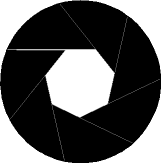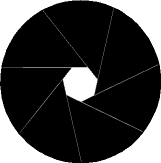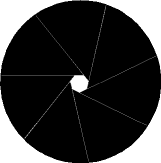Digression #1A note about the digressions: The digressions are intended as "extra" material that is not really important to understand. They're here in case you're interested and are willing to slog through some technical talk on the way to grasping an esoteric concept. If you don't really care, or you just don't want to spend the time grappling with the math or whatever, then just skip the digressions. You won't be missing anything important. Sometimes you'll hear photographers say "f-stop" instead of aperture. Then they'll talk about an exposure being "off by a full stop." Then they'll mutter something about needing a "wider" lens. What does all this gook mean, and why on earth is f/4 not twice as much light as f/8? All that and more you will learn in this digression. What exactly is an aperture, and why is it written f/8 ?
Towards the back of the lens there is an iris that can open and close. The iris is typically made of 7 blades that can slide over each other. Twisting the aperture ring on the lens one way moves the blades closer together, closing the iris. Twisting it the other way moves the blade farther apart, opening the iris. As you open it, it allows more of the light gathered by the lens to reach the film. As you close it, it cuts off some of the light. Figure 1 shows a schematic diagram of an aperture iris. There isn't really a gap between the blades; the white lines are there just to show you where the iris blades are located. The aperture number you see represents the diameter of the lens opening as the physical diameter of the opening (in cm, mm, inches, whatever; it doesn't matter) divided into the focal length of the lens (in the same units, of course). In other words, the f/stop is the diameter of the opening represented as a fraction of the lens length. That's why the aperture is written as f / some number. f is the focal length of the lens. For example, let's say you have a 80 mm lens. If the aperture is set to f/8, the diameter of the lens opening is 80mm/8, or 10mm. At f/4, the lens opening is set to 20 mm. This is why increasing the aperture number (or "f-stop") decreases the amount of light; you're dividing a fixed number (the focal length of the lens) by an increasing one, so the fraction gets smaller. When you go from f/4 to f/8, you've decreased the lens opening from 1/4 the lens length to 1/8 the lens length--thus admitting less light (not half as much, but one quarter as much--keep reading for an explanation of why). By the way, you'll frequently see people write the aperture setting as "f-8"
or "f 8". Both of these are technically incorrect.
The proper way to write the aperture setting is "f / 8". So when you read
a photography magazine in the future and the reporter writes "1/125 at f-16,"
you're permitted a small knowing chuckle. :) Apertures and Buying a Lens
When it comes to apertures, the smaller the number, the bigger the diameter of the lens. That's why a 200mm f/2.8 lens costs a lot more than a 200mm f/4 lens--that 200mm f/2.8 lens is 71mm (2.8 inches) in diameter! That sounds like the front lens is only 1.4 times the diameter (it is)--but that means it's twice the area! Since the amount of glass used in the lens is proportional to the area, the front element of that f/2.8 lens costs twice as much in raw materials as the same element on the f/4 lens--and it's harder to manufacture, too. That's also why you see zoom lenses represented as 28-80mm f/3.5-5.6, as some lens of yours is probably marked (just a guess). The diameter of the lens doesn't change as you zoom, but the focal length does. By dividing the same lens diameter by a larger focal length, you get a smaller maximum aperture (i.e. a larger aperture number). At 28 mm, the max. aperture of the lens is f/3.5 When you zoom it out to 80mm, it has the same diameter, but it's almost 3 times as long...so it becomes an f/5.6 lens. Zoom lenses are strange in their optics, so the straight computation of element size / aperture opening doesn't apply, but you get the idea. The terminology gets worse, believe it or not. "Faster" and "slower" are terms applied to lenses. An f/2.8 lens is "faster" than an f/4 lens. Why? because the f/2.8 lens will have an aperture setting of f/2.8, which admits twice as much light as the max. f/4 that the other lens can do. That means you can set the shutter speed to be twice as fast with the fast lens as you could with the slow lens. Why does twice the aperture number mean one fourth the light?
Figure 2 shows this graphically. In each succeeding step, the diameter has been reduced by half. The thing to look at is the size of the white portion in the center of the lens; this is the portion of the lens that admits light. It should be obvious to you that when you go from f/2.8 to f/5.6, the central portion does not halve in size. It's hard to estimate that it quarters, but I assure you that's the case.
Here's a quick quiz for you:
Get the idea? Basically they're all 1.4, plus or minus a little. Why? I'll give you a hint: what is the square root of 2? So every two stops gets you to double the number you started from (i.e. 2.8 -> 4 -> 5.6 ), which corresponds to half the aperture, which in turn yields one quarter the light. What the hell is a "stop"?Sometimes you'll hear photographers talk about exposures and they'll say something like "that was off by a full stop." The "stop" specifically means "aperture stop," because even the old-style "photographer stands under a hood and opens the shutter with a cable release" cameras that had no shutter speed controls had aperture settings on the lenses. And those aperture settings were usually marked with little bumps that would cause the aperture ring to stop at places known to be "full" aperture settings (like f/2.8, f/4, etc.). Each "stop" would get you twice as much (or half as much) light as the one before it. In general what the photographer really meant was that he had twice too much (or half as much) light as needed. But the phrase "f-stop" gradually got shortened to "stop," and now it's stuck that way. So if you're a "full stop underexposed," you need to open your aperture "one stop" to get the right exposure, or go for twice the shutter time (i.e. half the shutter speed). Stop Down, Open up...what the hell are you talking about?Basically, there are dozens of terms which all mean the same thing. "Open Up," "wider," etc. all mean "go to a smaller aperture number," or "open the iris more." "Stop down," "clamp down," etc. all mean "go to a higher aperture number," or "close the iris more."
|
About | UW Photos | Scuba Picture Uv the Day | Flower Gardens | Aquashot | Trip Reports | RSDiver | Photo Instruction | News | Desktop/Screensaver Images | Site Map |
||
